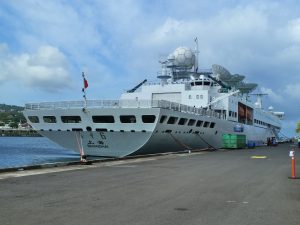Following wide speculation, India postponed its missile test launch, originally planned between November 10-11 in the Indian Ocean Region (IOR). The new launch window is now November 23-24. Various defense journalists and analysts held the presence of China’s “research vessel” Yuan Wang 6 responsible for the postponement.
The Yuan Wang class of ships are known to have powerful satellite and missile tracking and surveillance capabilities. The People’s Liberation Army Strategic Support Force (PLASSF), the branch of the Chinese military responsible for space, cyber, and electronic warfare, operates these vessels. Though classified as non-military research vessels, China uses the Yuan Wang ships for spying purposes.
The Indian national media quickly picked up social media updates on the ship’s movement toward the Bay of Bengal, and the news spread like wildfire. From defense analysts to people high up in the Indian establishment, many were concerned that China would be able to use the Yuan Wang 6 to get vital information about Indian missiles’ capabilities, such as their trajectory, speed, range and accuracy. The Indian security establishment subsequently deferred the missile test.
The whole episode raises important questions, with implications for India’s maritime strategy and its signaling to China and regional partners.
First, it highlights India’s paranoia and, to an extent, incorrect assessment of the Chinese maritime threat. China has the ability to track the missile even without sending the Yuan Wang 6. Not only are these ships repeatedly deployed by China in the event of any major foreign launch announcements, but other countries do the same. India itself also has a ship called INS Dhruva for these tracking and surveillance purposes.
Second, the reason for deferring the test launch could either be India’s lack of confidence in its capabilities or a lack of capabilities themselves in securely carrying out the test. Whichever may be the reason, both would strengthen China’s resolve and confidence in carrying out similar operations in the IOR. For China, in the region where India sees itself as the “net security provider,” even a low-cost and low-risk operation like this can disrupt its strategic activities.
Third, the Indian reaction provides a reality check to the growing rhetoric of “India arriving on the world stage” and “India as a great power.” In both Yuan Wang ship-related incidents – this one and a previous incident involving the Yuan Wang 5 docking in Sri Lanka – India’s projected the image of a chronically insecure power that lacks the patience, confidence, and strategy to deal with China’s growing maritime presence in its neighborhood.
Fourth, the event reflects New Delhi’s continuing continental mindset in thinking about threats and associated security definitions. The Chinese vessel is well within the range of international maritime law to operate inside the IOR. The law provides the ship unfettered access to the waters it is currently in and even to the Indian Exclusive Economic Zone (EEZ). However, New Delhi seems to have applied the territorial definition of border transgression to the IOR, treating the Yuan Wang 6’s presence as a violation of its sovereign maritime space. A similar mindset created an unpleasant incident between the United States and India when the U.S. Navy carried out a Freedom of Navigation Operation (FONOP) in the Indian EEZ near the Lakshadweep Islands.
For India, these episodes also have international reputational costs associated with them. On the one hand, India’s credentials as a strong security partner in the Indo-Pacific region weaken. On the other, it negatively affects India’s grandstanding as an ardent follower of international law. For regional partners such as Australia, Japan, and Vietnam, both these aspects carry weight in the bilateral relationship. Also, in the absence of objective and unbiased scrutiny by the Indian media, such knee-jerk reactions leave the domestic public puzzled about India’s strategy and operational preparedness to check an increasingly assertive China.
It is possible that the postponement of the missile test may be unrelated to the movement of the Chinese spy ship. In the weekly media briefing, India’s Ministry of External Affairs spokesperson did not associate the two and declined to comment in detail on a security issue. If so, the overplaying of the two spy ship incidents and the test’s deferment might be India’s reminder to the United States and other Western partners that, while the Eastern European theater may be of immediate concern, it is the Indo-Pacific where the future danger lies.
In any case, India needs to accept the new strategic reality of increasing Chinese footprints in the IOR. During the new launch window, both Yuan Wang 5 and Yuan Wang 6 could be operating near the declared no-fly zone. India cannot avoid Chinese spy ships and satellites in the region, and they should not affect India’s strategic activities in this maritime space. In effect, India needs to adopt a pragmatic strategy to check the same, keeping the ways, means, and ends in mind. Both threat inflation and deflation are problems that impact meaningful assessment of the adversary’s capabilities. Reactionary and immature tactical responses may be helpful in the short term, but the absence of strategy will have significant security and audience costs in the long run.

































